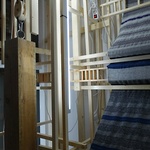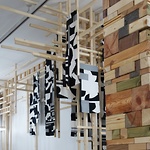Tillvarons ornamentik - Petter Hellsing - SOFT galleri
Through several exhibitions, Hellsing has pursued the theme of alteration between chaos and order in globalized cities. At SOFT Galleri, he continues exploring this theme through a site-specific improvisation entitled Tillvarons Ornamentik (The Ornamentation of Existence). With simple weavings, textile collages, ceramics, animation and wood, he builds the installation during an intense ten-day period leading up to the exhibition opening. The creative process is a central part of the work.
Hellsing has a special interest in modern China, having himself experienced the energy of its rapid urban transformation. Changes in the social and physical landscape erase the boundary between the local and the global sphere. In a city of cement and steel, textiles have a specific role to play. As temporary constructions, they can create flexible places in the urban space between the private and public domain and become a challenge to permanent architecture. For his exhibition at SOFT Galleri, Hellsing approaches the ornamentation of existence through improvisation made by hand. The hand reads the pattern of change, allowing a story to emerge in the gallery room, in the now and in social dialogue. The rhythm in his warp and woof repeats in his wooden architectonic constructions. The size of the body and hands are reflected in the crafting process. It is an action which communicates a story through sensory experience, where the idea continues through the hand, and the hand extends the body out towards the world through the crafting tool.
Stripes against Chaos
Stripes are a recurring motif in Petter Hellsing’s installation Tilvarons Ornamentik (The Ornamentation of Existence). While his woven textiles are richly furnished with stripes, they also appear as a logical consequence of how the wooden constructions are built. The stripes are both structure and decoration in this total installation, but they are much more besides. Regardless of being wide, narrow, thick or as thin as a line, stripes are a cultural symbol, a sign for something created and constructed. And they can have many functions. In a chaotic world, we use stripes to create visual and concrete order. We use them to mark boundaries and divisions. Not least, in the chaos of impressions in a large city, we seem to have an innate will to sort and order our impressions according to specific patterns. The buildings in an urban landscape therefore allow themselves to be experienced as a pattern built on repetition and variation in rhythmic intervals. The word choice for the title of this installation is deliberate. Ornamentation has much in common with music, and as a rhythmic art form, it appeals first and foremost to the body and to feelings.
Each and every stripe is a rhythm, a kind of visual music stretching out in time and creating movement: Where does it begin and where does it end? What is under and what is over? Stripes catch our attention and create visual tension. It is not surprising that many painters are interested in what they can do with stripes. Petter Hellsing’s striped weavings participate in a dialogue with this painterly tradition, but they are also deeply rooted in folk-traditions for weaving in many places in the world. To weave has largely been identical to creating striped patterns. Through his entire artistic practice, Petter Hellsing has been keen to challenge contemporary art’s understanding of what should be considered relevant media and techniques, and of what is artistically central. His art points towards other possible answers, not least by opening up for ornamentation as one way of sensing existence.
Jorunn Veiteberg










